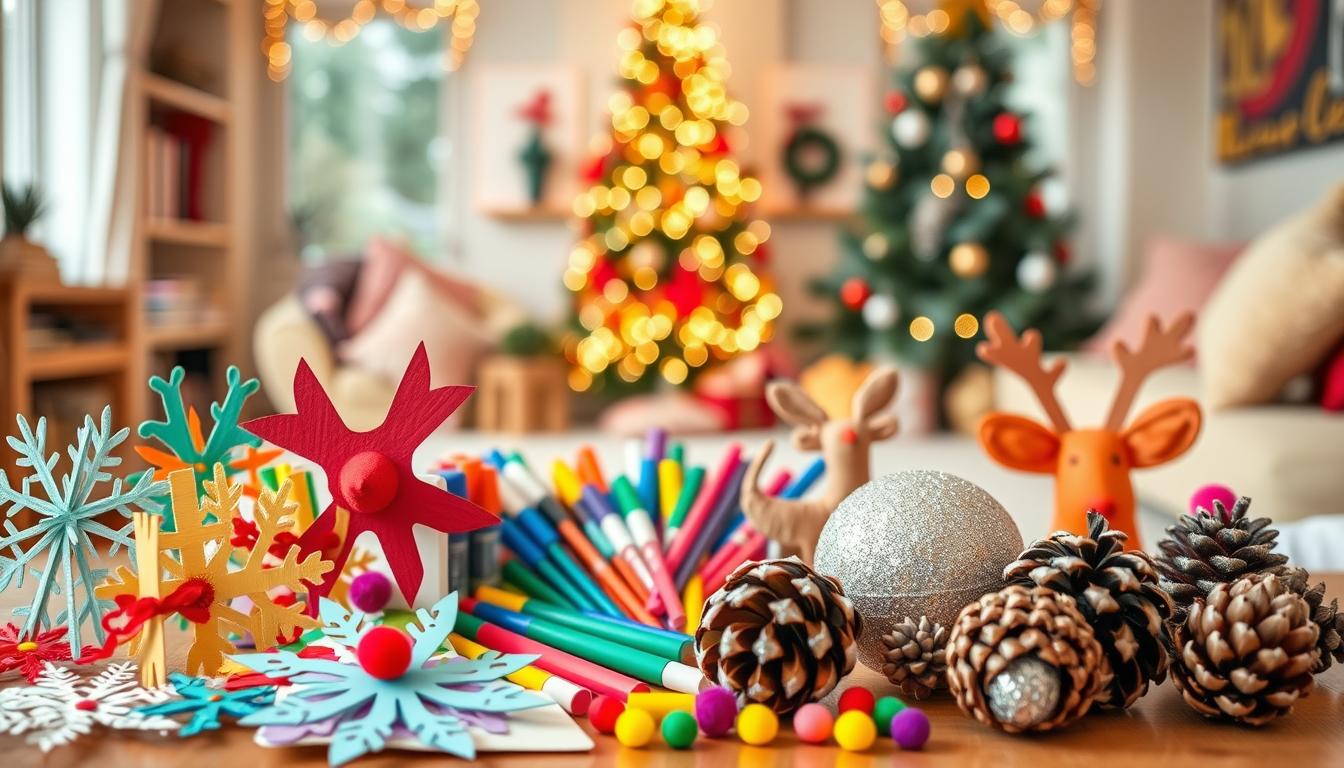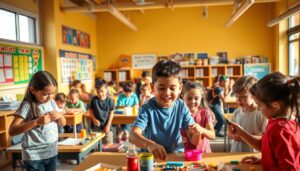DIY Holiday Crafts for Little Ones
“Play is often talked about as if it were a relief from serious learning. But for children, play is serious learning.” – Fred Rogers
The festive season offers a golden chance to bond with young ones through hands-on creativity. Simple projects transform ordinary afternoons into magical moments where glue sticks become wands and construction paper turns into winter wonderlands. These activities do more than fill time – they build coordination, spark imagination, and create heirlooms you’ll treasure for years.
This guide helps families discover joyful projects using everyday items. From salt dough ornaments to upcycled gift wrap, you’ll find ideas that fit any age or skill level. Best part? Most materials already live in your kitchen drawers or recycling bin.
Key Takeaways
- Creative projects strengthen family connections while teaching practical skills
- Age-appropriate activities boost fine motor development and artistic confidence
- Common household items become tools for imagination and sustainability lessons
- Screen-free time encourages meaningful conversations and shared accomplishments
- Handmade decorations create lasting memories and personalized holiday traditions
Introduction to Festive DIY Holiday Crafts
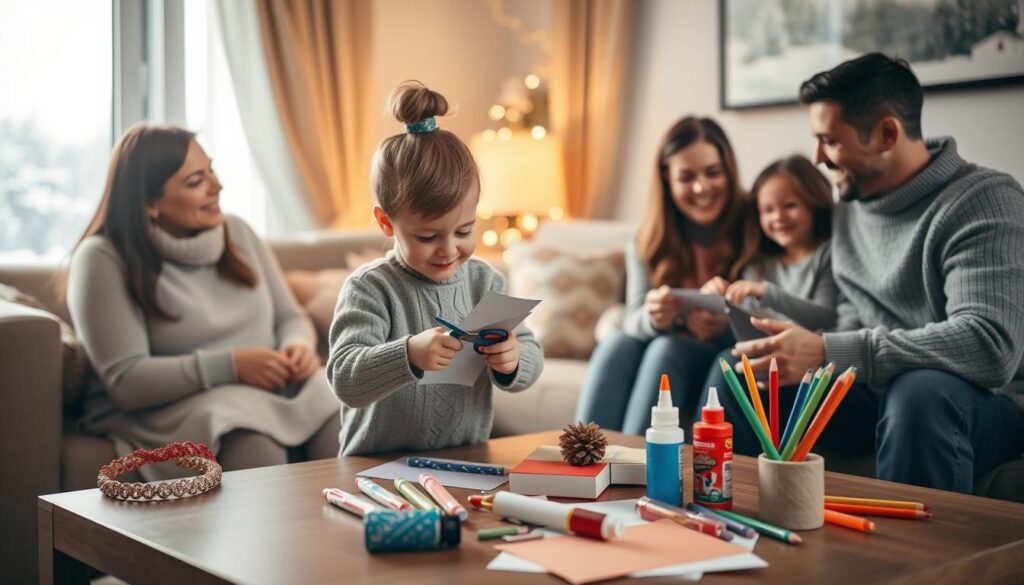
Gathering around the table with glitter and glue marks the start of something special. The holiday season turns everyday spaces into workshops where little hands shape memories one paper snowflake at a time.
Setting the Holiday Spirit
Twinkling lights and cinnamon scents set the stage, but shared creativity makes moments stick. When kids see their handiwork displayed, they connect effort with celebration. Simple projects like fingerprint stockings or painted pinecones become anchors for yearly traditions.
These activities build anticipation better than any countdown calendar. The clatter of scissors and rustle of tissue paper signal that magic’s brewing. Adults get bonus points for playing holiday tunes during craft sessions!
Why Craft Time Is Family Time
Mismatched mittens sticky with glue? Totally normal. Lopsided ornaments? Pure gold. Collaborative projects teach teamwork without lectures. Parents guide without taking over – letting kids problem-solve builds resilience.
Busy schedules fade when you’re elbow-deep in sparkles. Conversations flow easier when hands are busy. Finished pieces become conversation starters when guests visit: “See this reindeer? I made the antlers ALL by myself!”
Through shared laughter and occasional glitter disasters, families create something better than Pinterest-perfect decorations – they build connections that outlast any season.
Choosing the Right Materials and Tools
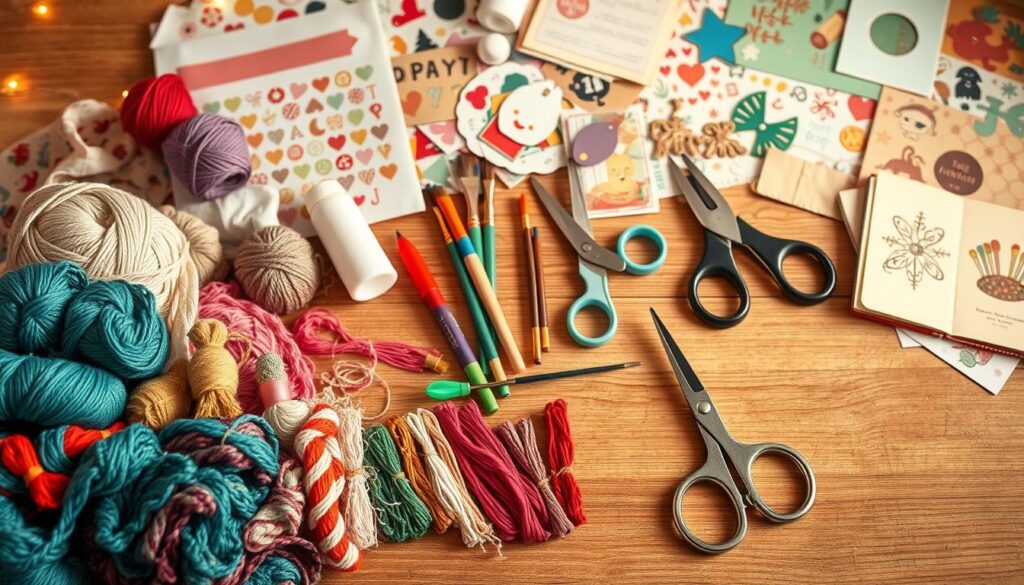
Building a creative toolkit starts with smart selections. The right materials and tools transform simple ideas into keepsakes while keeping little hands safe. Let’s explore what every family needs to turn imagination into reality.
Essential Craft Supplies
Stock your workspace with these basics:
| Supply Type | Basic Options | Advanced Options | Notes |
|---|---|---|---|
| Paper | Construction paper, cardstock | Metallic foil sheets | Mix textures for sensory play |
| Adhesives | Washable glue sticks | Low-temp hot glue guns | Adult supervision required |
| Cutting Tools | Safety scissors | Precision craft knives | Age-appropriate sizes |
| Decorations | Washable markers | Sequins, beads | Store in clear containers |
Non-toxic paints and chunky brushes work best for younger creators. Plastic organizers with compartments keep supplies visible and accessible. Rotate materials seasonally to maintain excitement.
Tips for a Safe Craft Session
Always pair sharp tools with close supervision. Low-temperature glue guns reduce burn risks compared to standard models. Keep craft spaces well-ventilated when using sprays or acrylics.
Create a “safety first” kit with bandages, wet wipes, and emergency contact numbers. Choose rounded-tip scissors for beginners – they cut paper but not fingers. Washable materials save both clothes and sanity.
Designate separate work zones for messy projects. A vinyl tablecloth protects surfaces and makes cleanup swift. Remember: laughter cleans up easier than glitter!
Engaging Holiday Crafts for Little Ones
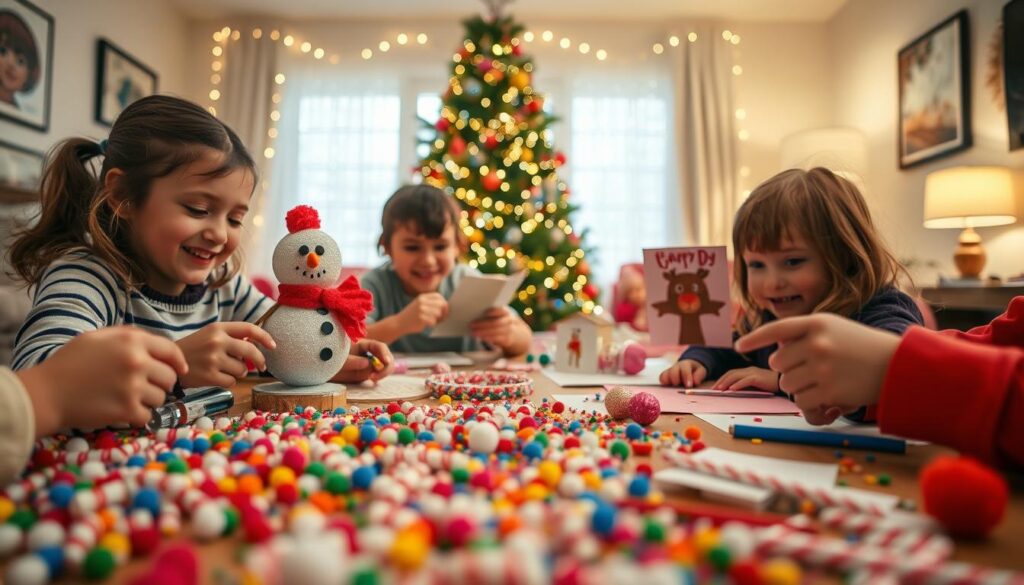
Little hands thrive when given colorful projects that celebrate seasonal joy. These four activities turn ordinary supplies into magical creations while teaching valuable skills. Best part? Each project fits different ages and interests.
Fun Ideas to Spark Creativity
Paper cookie decorations let children design without frosting stains. They cut dough shapes from cardstock, then add glitter “sprinkles” and marker details. These ornaments build scissor control and color matching skills.
Empty toilet rolls become mini evergreen forests. Kids paint rolls green, then glue twine trunks and Q-tip snowflakes. This craft shows how trash can transform into treasure through imagination.
| Craft Project | Skills Developed | Materials Needed | Display Ideas |
|---|---|---|---|
| Paper Cookies | Cutting, patterning | Cardstock, glitter glue | Tree ornaments |
| Roll Trees | Painting, assembly | TP rolls, acrylics | Tabletop forest |
| Pine Cone Trees | Nature observation | Cones, wine corks | Mantel display |
| Sparkly Dreidels | Cultural learning | Cardstock, glitter | Hanukkah décor |
Mini pine cone trees bring nature indoors. Children spray-paint cones green, then glue them to cork bases. Adding bead “lights” teaches precision while creating lifelike winter scenes.
For Hanukkah celebrations, cardstock dreidels shine with glitter accents. Kids practice measuring triangles and discover cultural symbols through hands-on making. Each finished piece becomes a conversation starter about traditions.
These ideas balance guidance with creative freedom. Whether making ornaments or upcycled décor, children gain confidence seeing their work displayed proudly. Messy hands mean growing minds!
Crafting with Household Items and Recycled Materials
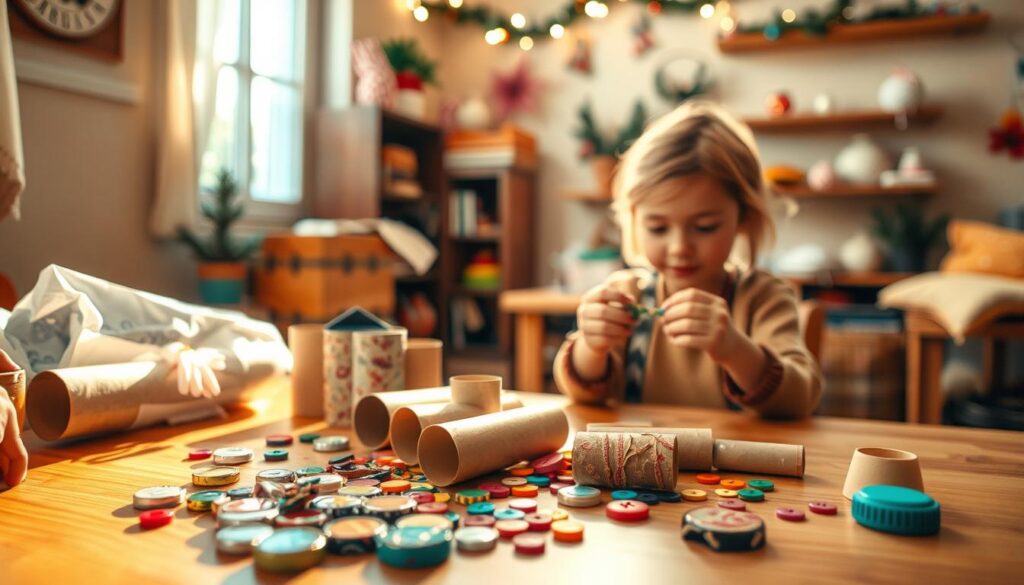
Empty paper rolls and glass bottles hold hidden potential waiting to burst into life. With some glue and imagination, families can turn ordinary objects into extraordinary decorations while teaching valuable lessons about resourcefulness.
Upcycling Everyday Objects
Transform bathroom leftovers into cheerful snowmen using white paint and marker details. Kids learn measurement skills while wrapping paper rolls with colorful scarves cut from old fabric scraps. These frosty friends make perfect shelf decorations or gift toppers.
Empty wine bottles become twinkling candle holders with adult supervision. Children arrange evergreen sprigs in water-filled bases, then watch real candles glow through recycled glass. This project blends nature with materials that usually head to recycling bins.
Here’s how common items stack up as creative tools:
| Item | New Purpose | Skills Practiced |
|---|---|---|
| Toilet paper rolls | Toy drum ornaments | Painting precision |
| Washi tape | Decorative patterns | Color coordination |
| Plastic bottles | Indoor herb planters | Botany basics |
Simple projects using paper and household glue prove creativity needs no fancy supplies. When children see cereal boxes become gift tags or egg cartons transform into wreaths, they learn sustainability through action. Bonus? No craft store runs required!
These activities do more than fill time – they reshape how young minds view everyday materials. A painted tin can becomes a pencil holder, worn jeans turn into quilted stockings, and suddenly “trash” gets a second act. That’s the magic of seeing potential where others see waste.
Decorating Your Home with Wreaths and Ornaments
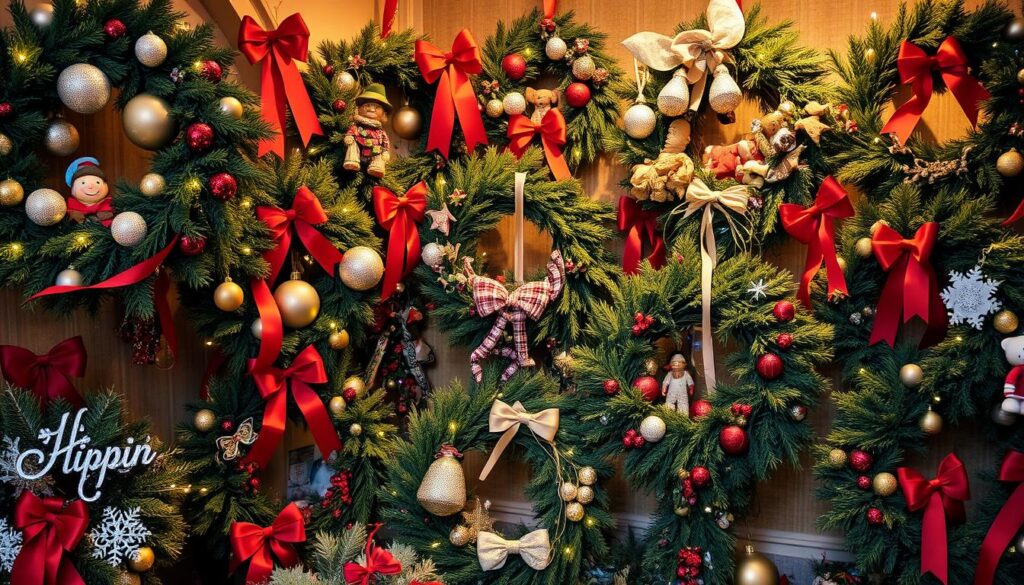
Your front door becomes a canvas and mantels turn into galleries when little artists join the decorating crew. These projects blend home aesthetics with hands-on learning, creating displays that sparkle with personality and pride.
Ribbon Wreaths and Tinsel Accents
Gold satin ribbon transforms basic wreath forms into luxurious door decor. Kids cut 8-inch strips, practicing measurement skills while tying elegant knots. “The crinkle of ribbon teaches patience – each loop needs just the right tension,” says crafting expert Marissa Cole.
Modern tinsel designs offer shimmer without mess. Children layer metallic strands carefully, discovering how light plays with textures. This project builds spatial awareness as they balance density and sparkle across the surface.
Paper Chain Garlands and DIY Cupcake Liner Ornaments
Leftover wrapping paper finds new life as cheerful chains. Cutting 3×6″ strips strengthens scissor control, while looping and stapling develops pattern recognition. These garlands become math lessons in disguise – count links together as they grow!
Flattened cupcake liners morph into 3D ornaments with glue dots. Folding techniques reveal hidden geometry lessons as circles become spheres. Display these airy creations in windows where sunlight highlights their delicate folds.
| Project | Skill Focus | Conversation Starter |
|---|---|---|
| Ribbon Wreath | Pattern repetition | “How does texture change a room’s feel?” |
| Paper Chains | Measurement math | “What patterns do you see in our garland?” |
| Cupcake Ornaments | Structural engineering | “Why do spheres catch light differently?” |
Through these decorations, children learn that home spaces reflect their creativity. A ribbon bow tied slightly crooked becomes a badge of authentic effort – proof that beauty lives in joyful attempts, not perfection.
Seasonal Crafts Using Natural Elements
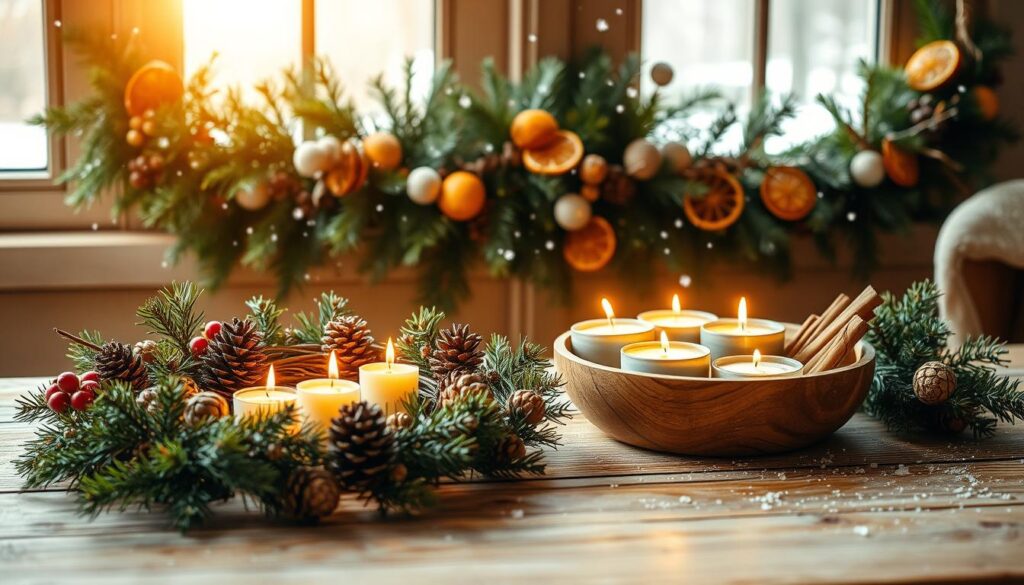
Pinecones and citrus aren’t just seasonal items—they’re gateways to sensory play. Winter’s bare branches and spice-filled pantries offer endless possibilities for creations that engage sight, smell, and touch. These projects turn nature walks into treasure hunts and kitchen staples into aromatic masterpieces.
Pinecones, Cinnamon Sticks, and Citrus Pomanders
Orange clove pomanders turn snack time into art time. Kids use skewers to poke holes in citrus fruits, then press whole cloves into the patterns. The zesty scent fills rooms naturally, teaching about botanical fragrances. “The combination of citrus and spices makes winter feel warmer,” notes herbalist Lila Monroe.
Cinnamon stick bundles become instant centerpieces. Children tie 5-7 sticks with twine, adding dried orange slices or pine sprigs. These aromatic pieces double as napkin rings or gift accents. The warm spice scent lasts throughout the season.
| Project | Materials | Skills Developed |
|---|---|---|
| Citrus Pomanders | Oranges, cloves | Pattern design |
| Cinnamon Bundles | Sticks, twine | Measurement |
| Pinecone Trees | Cones, corks | Balance |
| Fire Starters | Wax, pinecones | Material science |
Foraged fire starters mix science with creativity. Kids layer pinecones, coffee beans, and cinnamon sticks in cupcake liners. Pouring melted wax (adult job!) teaches states of matter. These functional pieces make bonfire nights extra special.
Working with natural materials connects children to seasonal cycles. Crunchy leaves become confetti, frozen berries transform into paint—every element tells a winter story. Best part? No two creations look alike, celebrating nature’s beautiful imperfections.
Upcycled Holiday Projects and Recycled Inspirations
Breathing new life into forgotten items sparks both creativity and eco-consciousness in young minds. Simple materials become extraordinary when paired with imagination and basic tools. These projects turn “trash” into meaningful decorations while teaching resourcefulness.
Twine-Wrapped Lightbulb Decorations
Burnt-out bulbs find new purpose as rustic ornaments. Kids wrap twine around the glass using hot glue, creating textured patterns. Add twig stems and paper leaves to transform them into charming pear shapes.
This activity develops patience and fine motor control. The hot glue gun (adult-handled) teaches tool safety basics. Finished pieces glow warmly when hung near window lights.
Upcycled Bottle Candle Holders
Empty wine bottles become elegant centerpieces with minimal effort. Children arrange evergreen sprigs in water-filled bottles, then place floating candles on top. The project combines nature exploration with practical design skills.
Use twine to wrap bottle necks for added texture. Non-toxic glue secures decorative accents like dried citrus slices. These creations showcase how everyday items can shine with thoughtful reuse.
Through these upcycled projects, children learn sustainability hands-on. Each finished piece tells a story of transformation – proving creativity thrives when we see potential in the ordinary.
FAQ
What are the safest materials for kids’ holiday projects?
How can I involve toddlers in festive crafting?
Can I make decorations without buying new supplies?
What natural elements work best for winter-themed crafts?
How do I make homemade ornaments durable?
Are there quick projects for busy families?

Adam Peter is a finance, travel, and automotive writer with over a decade of experience. He creates clear, practical content to help readers manage their money, explore the world with confidence, and make informed decisions about cars and travel gear. His work blends expert insight with real-world usefulness.

